| Pages:
1
..
24
25
26
27 |
Hennig Brand
International Hazard
    
Posts: 1284
Registered: 7-6-2009
Member Is Offline
Mood: No Mood
|
|
Seems kind of dangerous and an awful waste as well. Rather than waste all that nitric acid why not use most of it to nitrate an aromatic compound,
like is described here:
http://www.sciencemadness.org/talk/viewthread.php?tid=19861
The sulfuric acid could be much more easily and safely recovered afterwards.
The experimenter in the video probably could have made a fair bit of sodium or potassium nitrite if he or she had bubbled the nitrogen oxides through
a solution of either sodium carbonate or hydroxide or potassium carbonate or hydroxide.
http://www.sciencemadness.org/talk/viewthread.php?tid=439&am...
I would personally use the first method and nitrate an aromatic compound to soak up most of the nitric acid before purifying and concentrating the
sulfuric acid.
[Edited on 15-8-2015 by Hennig Brand]
"A risk-free world is a very dull world, one from which we are apt to learn little of consequence." -Geerat Vermeij
|
|
|
ecos
Hazard to Others
  
Posts: 464
Registered: 6-3-2014
Member Is Offline
Mood: Learning !
|
|
Any traces on NG in the acid would make a big problem !
I read more about NG synthesis and i found two strange points :
1- sometimes they use air to flush NG
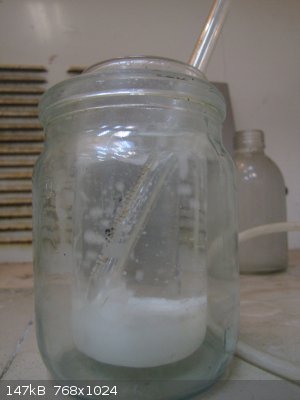
2- they use coffee filters to remove any impurities
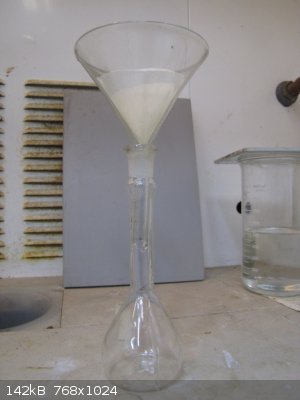
I didnt find both steps in my books. any idea?
both steps were under filtration of NG : https://www.youtube.com/watch?v=Jz5jx2LrZ2Q
[Edited on 14-8-2015 by ecos]
|
|
|
NeonPulse
Hazard to Others
  
Posts: 417
Registered: 29-6-2013
Location: The other end of the internet.
Member Is Offline
Mood: Isolated from Reality! For Real this time....
|
|
Using the air bubbler is to neutrallize the NG properly and takes far less time to do than simply rolling the NG around in the beaker. I have used
both methods and the bubbler is much better and took about 1/3 less time to do plus you can leave it to do its thing remotely and thus safely. not
sure about filtering it though. I cant see what would need filtering out of the NG if it is made properly.
On regeneration: couldn't you extract all of the last traces of the NG with chloroform and then regenerate the mixture more safely?(not that i'd ever
try this) i would be much more inclined to just get rid of it and start again for safety sake
|
|
|
ecos
Hazard to Others
  
Posts: 464
Registered: 6-3-2014
Member Is Offline
Mood: Learning !
|
|
I neutralize NG using sodium bicarbonate.... so what is the difference between sodium bicarbonate and air bubbling ?
|
|
|
greenlight
National Hazard
   
Posts: 705
Registered: 3-11-2014
Member Is Offline
Mood: Energetic
|
|
Air bubbling is bubbling air through NG in a solution of sodium bicarbonate with a pump. This agitates the NG, exposing more surface area to the
basic solution neutralizing residual acid faster and more effectively.
The only use for an atomic bomb is to keep somebody else from using one.
George Wald
|
|
|
ecos
Hazard to Others
  
Posts: 464
Registered: 6-3-2014
Member Is Offline
Mood: Learning !
|
|
ahaa. so stirring is not as efficient as bubbling air ?
|
|
|
PHILOU Zrealone
International Hazard
    
Posts: 2893
Registered: 20-5-2002
Location: Brussel
Member Is Offline
Mood: Bis-diazo-dinitro-hydroquinonic
|
|
Above a certain speed stirring is dangerous with NG... because the NG could be squeezed between two hard surfaces (recipient wall and agitator)... or
you could get cavitation bubbles and shock behind the blade. Cavitation bubbles reach very high inner pressure and temperature; that is why
ultrasonication is not an option here...
Bubbler is fine as a mixing way but the recipient shape must be addapted of course...
The risk of hard shock between a bubble and the recipient wall is 0! The only risk is more NG vapour in the air...
PH Z (PHILOU Zrealone)
"Physic is all what never works; Chemistry is all what stinks and explodes!"-"Life that deadly disease, sexually transmitted."(W.Allen)
|
|
|
greenlight
National Hazard
   
Posts: 705
Registered: 3-11-2014
Member Is Offline
Mood: Energetic
|
|
Yes, what PHILOU said, squeezing between the stir rod or (stir bar which would be even worse) and glass vessel wall could be a bad time . .
If you bubble air it would be much more effective plus you can turn the pump on and stay away just in case instead of sitting over the beaker
stirring.
[Edited on 16-8-2015 by greenlight]
The only use for an atomic bomb is to keep somebody else from using one.
George Wald
|
|
|
ecos
Hazard to Others
  
Posts: 464
Registered: 6-3-2014
Member Is Offline
Mood: Learning !
|
|
It is very good to take the best safety precautions when dealing with EM.
Almost 99% of all NG synthesis videos over internet uses magnetic stirrer. Almost all patents I read used magnetic stirrer as well !.
|
|
|
greenlight
National Hazard
   
Posts: 705
Registered: 3-11-2014
Member Is Offline
Mood: Energetic
|
|
100% correct. Minimize risk as much as possible = more chance of keeping your life/fingers/hands.
Magnetic stirrer would have to be a no. A stir bar spinning at any speed is creating friction and rubbing on the bottom of the glass vessel.
I have seen a couple of nitroglycerine synthesis clips on the net with people stirring to wash the NG very fast with a thermometer even banging the
sides a couple of times.
Even though nothing happens the 100th doing time doing it that way, it could detonate on the 101st.
The only use for an atomic bomb is to keep somebody else from using one.
George Wald
|
|
|
ecos
Hazard to Others
  
Posts: 464
Registered: 6-3-2014
Member Is Offline
Mood: Learning !
|
|
Hennig posted those photos for new setup to decrease the risk : http://www.sciencemadness.org/talk/viewthread.php?tid=949&am...
for lab :
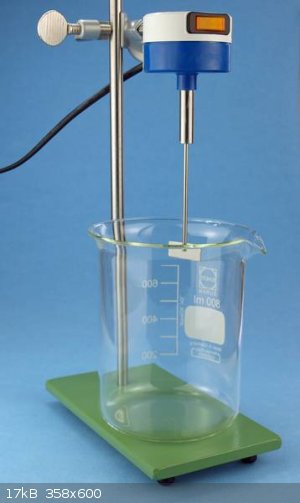
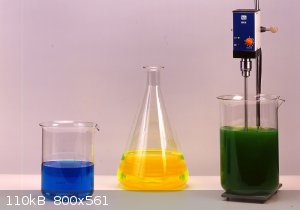
NG is very sensitive to viberation , I recall it would be 200 Hz for detonation for NG.
even this setup would be risky for high speed rotation , is my understanding correct ?
[Edited on 16-8-2015 by ecos]
|
|
|
greenlight
National Hazard
   
Posts: 705
Registered: 3-11-2014
Member Is Offline
Mood: Energetic
|
|
That is quite a nice stir setup he has made.
I think it would be very safe as it is a battery drill so not much vibration at all and I don't think it would be operating full speed. Friction
would be the main enemy.
Drills vibrate more when they are drilling into something and there is resistance. With stirring a liquid there is hardly any and the stir-paddle is
quite small.
No chance of the paddle hitting the side of the flask either as long as the drill is well secured, you could position a thermometer in a clamp just
above the paddle and stir away when nitrating as well.
The actual lab overhead stirrer made for chem work looks interesting as well especially if it came with an acid resistant PTFE stir paddle. Probably
quite expensive though.
[Edited on 16-8-2015 by greenlight]
The only use for an atomic bomb is to keep somebody else from using one.
George Wald
|
|
|
Hennig Brand
International Hazard
    
Posts: 1284
Registered: 7-6-2009
Member Is Offline
Mood: No Mood
|
|
Thanks, just to refresh, at the low temperatures and acid concentrations of a nitric esterification 304 and 316 stainless steel stirring rods will
hold up well (corrosion is extremely slow). There are higher performance, more involved designs, but as far as stirrer paddles go even a relatively
simple, large, slow moving paddle seems to do the job well, at least on the small scale. As well as having good chemical resistance PTFE and HDPE are
both very low friction materials, and are very often used in applications where this property is important. Also, as was stated, as long as the
stirrer paddle is positioned correctly and secure, and the vessel is secured, there is little chance of the paddle contacting the sides of the vessel
anyway.
"A risk-free world is a very dull world, one from which we are apt to learn little of consequence." -Geerat Vermeij
|
|
|
ecos
Hazard to Others
  
Posts: 464
Registered: 6-3-2014
Member Is Offline
Mood: Learning !
|
|
I believe that magnetic stirrer is not the best option , Hennig stirrer would be a better solution.
the speed of stirring should be a factor in setup. Very high speed would add high risk to the nitration process.
As i stated, NG would detonate at 200 Hz vibration.
I would think the motor speed should not exceed 100 RPM to be in safe side. (just thoughts)
|
|
|
ecos
Hazard to Others
  
Posts: 464
Registered: 6-3-2014
Member Is Offline
Mood: Learning !
|
|
Just an interesting photo :
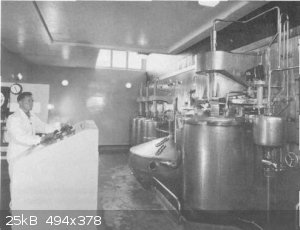
7 Biazzi fully automated nitration plant (nitroglycerine), 1956, the world's largest Biazzi plant.
it is very interesting the amount they nitrate 
[Edited on 20-8-2015 by ecos]
|
|
|
greenlight
National Hazard
   
Posts: 705
Registered: 3-11-2014
Member Is Offline
Mood: Energetic
|
|
I think they would have very strict temperature control with alarms if it went too high and a paddle stirrer inside. That is a large NG reaction
vessel thats for sure!
If too much of a temp climb happens (runaway) they can drown the reaction mix into a large vat of water below by pushing a button I have read.
[Edited on 20-8-2015 by greenlight]
The only use for an atomic bomb is to keep somebody else from using one.
George Wald
|
|
|
greenlight
National Hazard
   
Posts: 705
Registered: 3-11-2014
Member Is Offline
Mood: Energetic
|
|
Here's another interesting photo before of an early nitroglycerin manufacturing plant.
Nitrator's had to sit on a one legged stool so they paid attention and did not daydream/fall asleep while watching the temperature during the process.
[Edited on 20-8-2015 by greenlight]
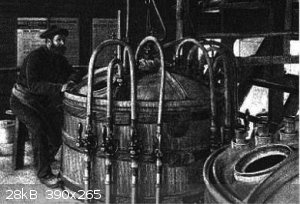
The only use for an atomic bomb is to keep somebody else from using one.
George Wald
|
|
|
kecskesajt
Hazard to Others
  
Posts: 299
Registered: 7-12-2014
Location: Hungary
Member Is Offline
Mood: No Mood
|
|
For purification:Why not dissolve NG into acetone and then add this to NaHCO3 solution?Or directly add NaHCO3 to the NG/Acetone?And then remove the
salt with water wash?
|
|
|
ecos
Hazard to Others
  
Posts: 464
Registered: 6-3-2014
Member Is Offline
Mood: Learning !
|
|
The interesting thing here is the temperature control system and the valves !
Many posts on the internet warn from using a separation funnel since the stopcock can be a source of hazard.
valves can cause a disaster specially with NG , is there any special designs for such valves?
|
|
|
greenlight
National Hazard
   
Posts: 705
Registered: 3-11-2014
Member Is Offline
Mood: Energetic
|
|
I think the valves are for the inflow of sulphuric, nitric and glycerin and air and water in and out for the cooling jacket. Some of them could also
be vents for pressure and fume release.
I think the reaction mixture is led from the main vessel to a floor below where it is skimmed off from the mixed acids with a special tool as is
stated on this page (quite an interesting article):
http://lateralscience.blogspot.com.au/2014/10/scottish-nitro...
[Edited on 20-8-2015 by greenlight]
[Edited on 20-8-2015 by greenlight]
The only use for an atomic bomb is to keep somebody else from using one.
George Wald
|
|
|
Bert
Super Administrator
        
Posts: 2821
Registered: 12-3-2004
Member Is Offline
Mood: " I think we are all going to die. I think that love is an illusion. We are flawed, my darling".
|
|
Quote: Originally posted by ecos  | The interesting thing here is the temperature control system and the valves !
Many posts on the internet warn from using a separation funnel since the stopcock can be a source of hazard.
valves can cause a disaster specially with NG , is there any special designs for such valves? |
You don't need a valve- Merely a rubber or acid safe plastic hose attached to bottom of reaction or washing vessels. Other end of hose is held up
above level of liquid in vessel until vessel is to be drained, then worker lowers end of hose to allow liquid to drain from bottom of vessel. Same
hose can be used to introduce air for agitation of NG and wash waters if vessel is small and no mechanical stirrer is wanted-
Rapopart’s Rules for critical commentary:
1. Attempt to re-express your target’s position so clearly, vividly and fairly that your target says: “Thanks, I wish I’d thought of putting it
that way.”
2. List any points of agreement (especially if they are not matters of general or widespread agreement).
3. Mention anything you have learned from your target.
4. Only then are you permitted to say so much as a word of rebuttal or criticism.
Anatol Rapoport was a Russian-born American mathematical psychologist (1911-2007).
|
|
|
PHILOU Zrealone
International Hazard
    
Posts: 2893
Registered: 20-5-2002
Location: Brussel
Member Is Offline
Mood: Bis-diazo-dinitro-hydroquinonic
|
|
Quote: Originally posted by kecskesajt  | | For purification:Why not dissolve NG into acetone and then add this to NaHCO3 solution?Or directly add NaHCO3 to the NG/Acetone?And then remove the
salt with water wash? |
If your NG is well cleaned, no problem;
otherwise
--> Have you ever put aceton in contact with HNO3 or with H2SO4?
1°)The first one goes runaway NxOy cloud in less than a minute.
2°)The second induces exothermic condensation and crotonisation into mesityl oxyde, phorone, mesitylen, ...
(CH3)2C=O + CH3-CO-CH3 --> (CH3)2C=CH-CO-CH3 + H2O
(CH3)2C=CH-CO-CH3 + O=C(CH3)2 --> (CH3)2C=CH-CO-CH=C(CH3)2 + H2O
3 (CH3)2C=O --> cyclo(-C(CH3)=CH-)3 + 3 H2O
[Edited on 20-8-2015 by PHILOU Zrealone]
PH Z (PHILOU Zrealone)
"Physic is all what never works; Chemistry is all what stinks and explodes!"-"Life that deadly disease, sexually transmitted."(W.Allen)
|
|
|
kecskesajt
Hazard to Others
  
Posts: 299
Registered: 7-12-2014
Location: Hungary
Member Is Offline
Mood: No Mood
|
|
Thanks,PHILOU, I never thinked about it.
|
|
|
ecos
Hazard to Others
  
Posts: 464
Registered: 6-3-2014
Member Is Offline
Mood: Learning !
|
|
Quote: Originally posted by Bert  | Quote: Originally posted by ecos  | The interesting thing here is the temperature control system and the valves !
Many posts on the internet warn from using a separation funnel since the stopcock can be a source of hazard.
valves can cause a disaster specially with NG , is there any special designs for such valves? |
You don't need a valve- Merely a rubber or acid safe plastic hose attached to bottom of reaction or washing vessels. Other end of hose is held up
above level of liquid in vessel until vessel is to be drained, then worker lowers end of hose to allow liquid to drain from bottom of vessel. Same
hose can be used to introduce air for agitation of NG and wash waters if vessel is small and no mechanical stirrer is wanted- |
Hi Bert,
I am already aware of this technique , I also saw it in the video : https://youtu.be/n3COSL_cIoc?t=5m34s
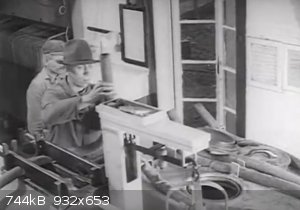
They also used something to stop the flow but it doesn't cut it completely.
In automated systems the use of valves would be logical to avoid any human mistakes !
[Edited on 21-8-2015 by ecos]
|
|
|
ecos
Hazard to Others
  
Posts: 464
Registered: 6-3-2014
Member Is Offline
Mood: Learning !
|
|
did you see someone shaking NG ?! I did :
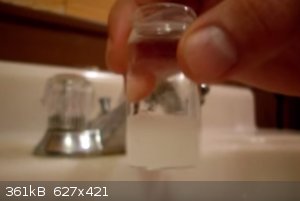
watch from here : https://youtu.be/LMU9JAK0Hik?t=2m59s
crazy people !
[Edited on 22-8-2015 by ecos]
|
|
|
| Pages:
1
..
24
25
26
27 |